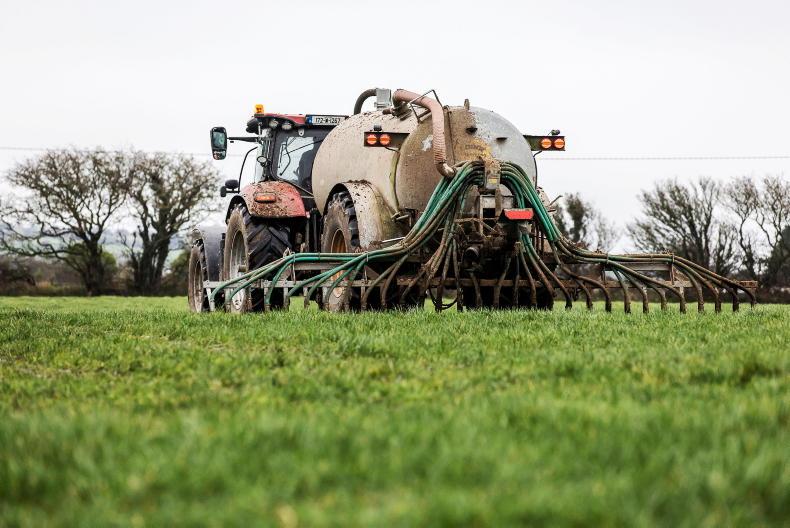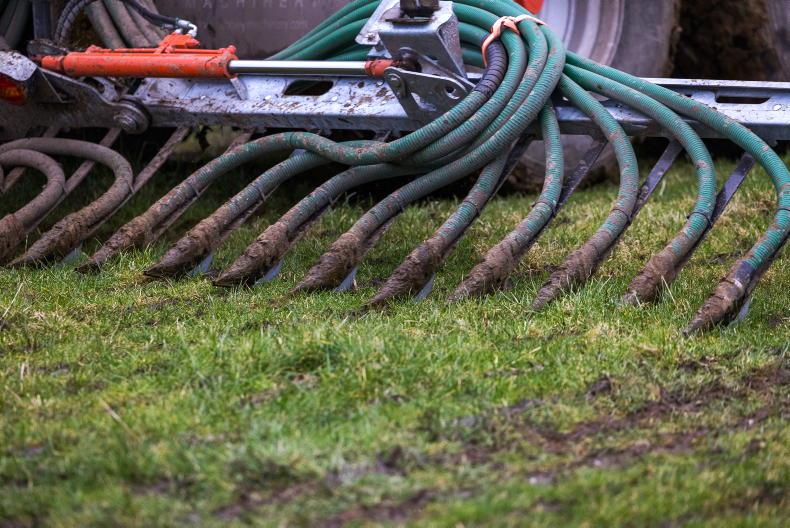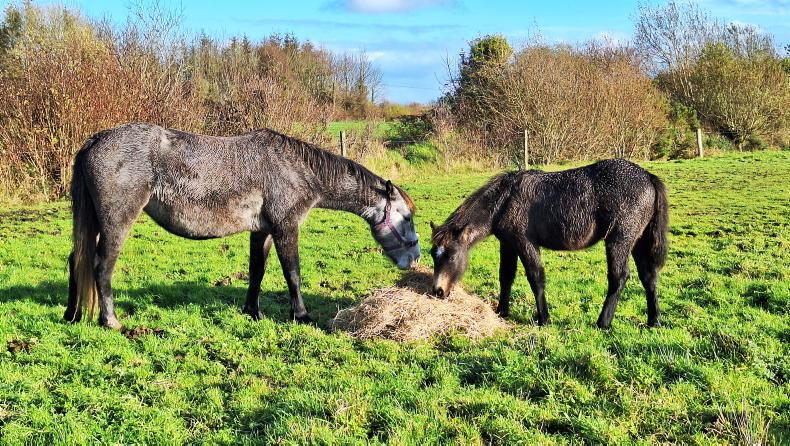Many farmers have availed of grant-aided support through the Targeted Agricultural Modernisation Scheme (TAMS) to make the move to low-emission slurry spreading (LESS) technology.
From the start of the slurry-spreading campaign this year, 6,786 derogation farmers are now required to spread all slurry using LESS technology.
From 15 April this year, this requirement will be extended to an extra 5,511 farms stocked above 170kg N/ha across the whole farm prior to exporting slurry from 2021.
This means a growing number of farmers will be using LESS equipment such as a dribble bar or trailing shoe for the first time this season in place of the traditional splash plate in line with regulations.
Research has shown the many benefits of the technology. However, farmers need to be aware that the forward speed when using a LESS system such as a dribble bar should be significantly increased over that when using a traditional splash plate to achieve the same application rate.
Increased forward speed
The increased forward speed required is something which is often overlooked, but is critical to ensuring even application at the correct rate. The faster speed at which the tanker will empty when using a LESS system over the splash plate is something first-time users will immediately notice.
Last week, we were in the field with a 2,750gal tanker which was using an 11,000l pump and was equipped with a 9m dribble bar. When using the splash plate, the average working width of the application on to the surface was approximately 13.5m and the time to empty was approximately six minutes and 25 seconds.
Next up, we trialled applying slurry through the dribble bar. This dribble bar had a 9m working width, had 40 outlets and used a Vogelsang macerator/distributor. Its time to empty was approximately four minutes and 25 seconds. So why did the tanker empty much quicker?
Slurry being applied through the splash plate has to be fed out through just one narrow gap, approximately 55mm. Meanwhile, when you move to a LESS system, the opening feeding the macerator is increased twofold, and up to threefold in some cases, in addition to far more outlets, so the tanker will naturally empty far quicker.
The point to note here is that when using LESS systems, the tractor’s forward speed needs to be significantly increased to match the splash plate’s application rate.
Application rate
Curious to note the difference in forward speed to apply our typical spring target rate of 2,500 gallons per acre, we used the Teagasc slurry calibration calculator.
The calculator requires four pieces of information in order to determine the forward speed required to apply the desired rate.
The details required include the size of the tanker being used, the working width of the application system, the time taken to empty the tanker and the targeted application rate. The calculator will then indicate the required forward speed in km/h to achieve the desired rate.
By entering all the above information from our trial, the calculator advised operating at a forward speed of 3.2km/h when using the splash plate, and over twice that speed of 7km/h when applying slurry with the dribble bar.
Although a 2,750gal tanker is larger than what most farmers are buying, so too is the 9m dribble bar. However, the concept of the increased forward speed remains the same. When moving to a new application method, it is important to ensure that you are applying the slurry evenly and at the correct rate.
The problem
The problem some farmers are running into is building up enough forward speed in the tractor to achieve the desired application rate, especially when working with more difficult conditions at the shoulders of the year.
Similarly, but to a lesser extent, when following up paddocks at lower application rates such as 1,500 gallons per acre during the summer months, forward speed needs to be upped even more, edging towards 12km/h using our above example.
Most tractors will comfortably achieve this forward speed, but not at the 300-400 PTO rpm (1,100rpm give or take engine speed) which most pumps run at.
Is the tractor fit?
Alongside increased forward speed, LESS systems place an increased hydraulic requirement on the tractor. Manufacturers tell us that new 2,000-2,600gal tankers with typical 7.5m LESS systems are what a lot of farmers are currently opting for.
Take a typical 7.5m dribble bar as the current day benchmark. To run the macerator correctly, there’s a hydraulic requirement in the region of 50l to 65l/min.
If the tractor uses closed-centre or load-sensing hydraulics, the oil flow will prioritise the tractor’s safety features, such as the steering and the brakes. The steering alone would sap approximately a further 20l/min, bringing the requirement up to 85l/min.
Depending on the tractor and its spec, its hydraulic set up and capacity will vary. Most should be OK, but it is worth double checking.
Tractors which use open-centre hydraulics may seem to have a lower hydraulic capacity, but are fitted with a second pump (20l to 30l/min) to cater for the steering. Tractors that use closed-centre or load-sensing hydraulics do not have this extra capacity.
A 100hp to 110hp tractor with a limited hydraulic capacity trying to meet the targeted forward speed for the application rate in challenging conditions at the shoulders of the year could find itself out of its depth.
Manufacturers will recommend a minimum of 120hp to 130hp tractor for a typical 2,300gal or 2,600gal tanker with a 7.5m LESS system, but it’s not all about power – weight is also important.
This is also one to watch, as many newer tractors are not weighted as heavily as their 20-year-old counterparts.
Before making the investment in LESS application systems, farmers need to ask themselves and their dealer whether their tractor is fit for purpose and is the system upgrade worth the investment.
The last thing you want to do is make a long-term investment in a new tanker and a LESS system, only to discover you have to go and update to a larger tractor, which will burn more fuel and will quite possibly be more awkward for other yard work.
In summary
When moving to a new slurry application method, it is vital to ensure that you are applying the slurry evenly and at the correct rate.When using LESS systems, the forward speed of the tractor will need to be increased considerably in order to maintain the same application rate as the splash plate.LESS systems also require an increased hydraulic capacity.Before making the investment in LESS application systems, farmers need to ask themselves is their tractor fit for purpose.
Many farmers have availed of grant-aided support through the Targeted Agricultural Modernisation Scheme (TAMS) to make the move to low-emission slurry spreading (LESS) technology.
From the start of the slurry-spreading campaign this year, 6,786 derogation farmers are now required to spread all slurry using LESS technology.
From 15 April this year, this requirement will be extended to an extra 5,511 farms stocked above 170kg N/ha across the whole farm prior to exporting slurry from 2021.
This means a growing number of farmers will be using LESS equipment such as a dribble bar or trailing shoe for the first time this season in place of the traditional splash plate in line with regulations.
Research has shown the many benefits of the technology. However, farmers need to be aware that the forward speed when using a LESS system such as a dribble bar should be significantly increased over that when using a traditional splash plate to achieve the same application rate.
Increased forward speed
The increased forward speed required is something which is often overlooked, but is critical to ensuring even application at the correct rate. The faster speed at which the tanker will empty when using a LESS system over the splash plate is something first-time users will immediately notice.
Last week, we were in the field with a 2,750gal tanker which was using an 11,000l pump and was equipped with a 9m dribble bar. When using the splash plate, the average working width of the application on to the surface was approximately 13.5m and the time to empty was approximately six minutes and 25 seconds.
Next up, we trialled applying slurry through the dribble bar. This dribble bar had a 9m working width, had 40 outlets and used a Vogelsang macerator/distributor. Its time to empty was approximately four minutes and 25 seconds. So why did the tanker empty much quicker?
Slurry being applied through the splash plate has to be fed out through just one narrow gap, approximately 55mm. Meanwhile, when you move to a LESS system, the opening feeding the macerator is increased twofold, and up to threefold in some cases, in addition to far more outlets, so the tanker will naturally empty far quicker.
The point to note here is that when using LESS systems, the tractor’s forward speed needs to be significantly increased to match the splash plate’s application rate.
Application rate
Curious to note the difference in forward speed to apply our typical spring target rate of 2,500 gallons per acre, we used the Teagasc slurry calibration calculator.
The calculator requires four pieces of information in order to determine the forward speed required to apply the desired rate.
The details required include the size of the tanker being used, the working width of the application system, the time taken to empty the tanker and the targeted application rate. The calculator will then indicate the required forward speed in km/h to achieve the desired rate.
By entering all the above information from our trial, the calculator advised operating at a forward speed of 3.2km/h when using the splash plate, and over twice that speed of 7km/h when applying slurry with the dribble bar.
Although a 2,750gal tanker is larger than what most farmers are buying, so too is the 9m dribble bar. However, the concept of the increased forward speed remains the same. When moving to a new application method, it is important to ensure that you are applying the slurry evenly and at the correct rate.
The problem
The problem some farmers are running into is building up enough forward speed in the tractor to achieve the desired application rate, especially when working with more difficult conditions at the shoulders of the year.
Similarly, but to a lesser extent, when following up paddocks at lower application rates such as 1,500 gallons per acre during the summer months, forward speed needs to be upped even more, edging towards 12km/h using our above example.
Most tractors will comfortably achieve this forward speed, but not at the 300-400 PTO rpm (1,100rpm give or take engine speed) which most pumps run at.
Is the tractor fit?
Alongside increased forward speed, LESS systems place an increased hydraulic requirement on the tractor. Manufacturers tell us that new 2,000-2,600gal tankers with typical 7.5m LESS systems are what a lot of farmers are currently opting for.
Take a typical 7.5m dribble bar as the current day benchmark. To run the macerator correctly, there’s a hydraulic requirement in the region of 50l to 65l/min.
If the tractor uses closed-centre or load-sensing hydraulics, the oil flow will prioritise the tractor’s safety features, such as the steering and the brakes. The steering alone would sap approximately a further 20l/min, bringing the requirement up to 85l/min.
Depending on the tractor and its spec, its hydraulic set up and capacity will vary. Most should be OK, but it is worth double checking.
Tractors which use open-centre hydraulics may seem to have a lower hydraulic capacity, but are fitted with a second pump (20l to 30l/min) to cater for the steering. Tractors that use closed-centre or load-sensing hydraulics do not have this extra capacity.
A 100hp to 110hp tractor with a limited hydraulic capacity trying to meet the targeted forward speed for the application rate in challenging conditions at the shoulders of the year could find itself out of its depth.
Manufacturers will recommend a minimum of 120hp to 130hp tractor for a typical 2,300gal or 2,600gal tanker with a 7.5m LESS system, but it’s not all about power – weight is also important.
This is also one to watch, as many newer tractors are not weighted as heavily as their 20-year-old counterparts.
Before making the investment in LESS application systems, farmers need to ask themselves and their dealer whether their tractor is fit for purpose and is the system upgrade worth the investment.
The last thing you want to do is make a long-term investment in a new tanker and a LESS system, only to discover you have to go and update to a larger tractor, which will burn more fuel and will quite possibly be more awkward for other yard work.
In summary
When moving to a new slurry application method, it is vital to ensure that you are applying the slurry evenly and at the correct rate.When using LESS systems, the forward speed of the tractor will need to be increased considerably in order to maintain the same application rate as the splash plate.LESS systems also require an increased hydraulic capacity.Before making the investment in LESS application systems, farmers need to ask themselves is their tractor fit for purpose. 








SHARING OPTIONS